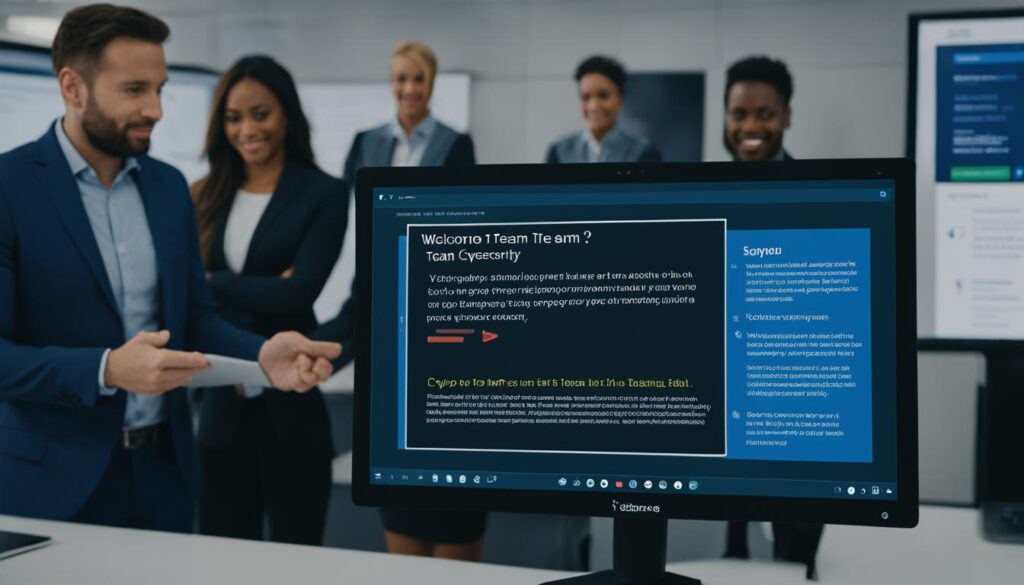Welcome to the ultimate guide to onboarding new developers! As a company, onboarding developers is a crucial process that sets the stage for their success and contributes to the overall growth and productivity of your organization. By implementing effective onboarding strategies, you can ensure that your new software engineers assimilate quickly and become valuable contributors to your team.
Research shows that a well-designed onboarding program can have a significant impact on the retention and productivity of new hires. In fact, studies have found that effective onboarding can improve new hire retention rates, increase productivity, and reduce turnover costs. So, it’s essential to invest time and effort into creating a comprehensive developer onboarding process.
Key Takeaways:
- Onboarding new developers is crucial for company success.
- Effective onboarding strategies can lead to improved retention and productivity.
- A comprehensive onboarding program should cover administrative tasks, assimilation into the team and work environment, and long-term career development.
- Onboarding programs should be manager-led, with HR providing guidance and support.
- Best practices for structuring an onboarding program include setting realistic expectations, providing a supportive environment, and offering pre-boarding activities.
The Impact of Onboarding on Retention and Productivity
When it comes to onboarding new hires, the process has a significant impact on both employee retention and productivity. According to Gallup, a well-planned onboarding program can retain 91% of new hires in their first year and increase retention rates by 58% after three years.1 This shows that a robust onboarding process is crucial for keeping your new developers engaged and committed to your organization.
But what about productivity? Turns out, an effective onboarding program can also significantly boost new hire productivity. It has been found that organizations with structured onboarding processes can increase new hire productivity by an impressive 50%.1 This means that by investing in a comprehensive onboarding program, you can ensure your new developers hit the ground running and contribute to your company’s success right from the start.
Not only does onboarding impact new hire retention and productivity, but it also plays a role in manager satisfaction. With a well-designed onboarding program, managers can experience a 20% increase in satisfaction levels, as they can witness their newly onboarded developers seamlessly integrate into the team and contribute to the overall goals of the organization.1
To achieve these desired outcomes, it’s important to implement onboarding best practices that focus on new hire orientation, training, and a seamless assimilation process into your company’s culture and work environment. By doing so, you’ll create a positive onboarding experience that sets your developers up for long-term success.
So, don’t underestimate the power of onboarding when it comes to retaining your new developers, maximizing their productivity, and ensuring overall team satisfaction. With effective onboarding practices in place, you can build a stronger and more successful organization.
- Gallup. (n.d.). How to Onboard Employees in Times of Change and Crisis. Retrieved from (URL)
What Should Onboarding Programs Cover?
When it comes to onboarding new developers, it’s essential to cover all aspects of their needs to ensure a smooth transition into their role. A comprehensive onboarding program should encompass various elements, including administrative tasks, assimilation into the team and work environment, company culture, vision, mission, and providing necessary training and policies.
- Administrative Tasks: The onboarding process should include handling administrative tasks, such as signing contracts and setting up access to essential tools and files. This ensures that new developers have everything they need to hit the ground running.
- Assimilation into the Team: It’s crucial to introduce new developers to their team members and create a welcoming environment. By fostering positive relationships and open communication, developers can better integrate into the team and feel supported.
- Company Culture, Vision, and Mission: A key aspect of onboarding is familiarizing new developers with the company’s culture, vision, and mission. This helps them understand the organization’s values and align their work with the company’s goals.
- Training and Policies: Providing necessary training specific to the developer’s role and ensuring they are aware of company policies is crucial. This helps developers gain the knowledge they need to perform their tasks effectively and adhere to company guidelines.
The ultimate goal of a comprehensive onboarding program is to facilitate a smooth transition for new developers, ensuring they feel supported, valued, and equipped with the necessary resources to excel in their roles.

Who’s Responsible for Onboarding the New Hire?
When it comes to onboarding new developers, it’s important to have a manager-led approach. The responsibility of onboarding is shared between Human Resources (HR), hiring managers, engineering managers, and C-level managers.
HR plays a crucial role in coordinating the onboarding process. They are responsible for scheduling onboarding appointments, introducing the new hire to tools and equipment, and ensuring that they feel welcomed and supported. HR professionals provide guidance and support to hiring managers throughout the onboarding journey.
Engineering managers take charge of introducing the new developer to the team structure and development goals. They play a key role in helping the new hire understand their role within the team and aligning their work with the overall objectives of the organization.
C-level managers, including executives and top-level leaders, also play a role in the onboarding process. They are responsible for aligning the new hire with the company’s vision and long-term goals. This helps the new developer gain a deeper understanding of the company culture and mission, ensuring a smooth transition into their role.
By having a manager-led onboarding process, companies can ensure that new developers receive the guidance and support they need to succeed. This comprehensive approach promotes a positive onboarding experience, setting the stage for a successful career with the company.
Best Practices for Structuring Your Onboarding Program
To create an effective onboarding program for your new developers, it’s important to prioritize certain strategies and practices. By following these best practices, you can ensure a seamless transition and a positive experience for your new hires.
1. Give New Developers Time to Get Acquainted
Effective onboarding begins with giving new developers the opportunity to get to know their team and understand the company culture. Encourage team members to introduce themselves and provide opportunities for social interactions. This will help new developers feel welcomed and build connections right from the start.
2. Set Realistic Expectations
When onboarding new developers, it’s crucial to set realistic expectations about their roles and responsibilities. Clearly communicate what is expected of them and provide a roadmap for their learning and growth within the company. This will help them understand their goals and feel motivated to contribute.
3. Create a Supportive Environment
Developers thrive in environments where they feel supported and encouraged. Foster a culture of collaboration and open communication, where new developers feel comfortable asking questions and seeking assistance. Regularly check in with them to address any challenges they may be facing and provide guidance when needed.
4. Pre-boarding Activities
Welcome new developers to your team even before their official start date. Consider organizing a video call to introduce them to their future colleagues, provide an overview of the company culture, and answer any initial questions they may have. This pre-boarding activity sets a positive tone and helps new developers feel excited about their new role.
5. Provide Resources and Assign Mentors
Equip new developers with the necessary resources to succeed. Provide an employee handbook that outlines the company’s policies and procedures, as well as any relevant technical documentation or training materials. Assign mentors or buddies who can guide them through their initial days and provide ongoing support.
6. Continuous Improvement and Feedback
An effective onboarding program should evolve with the needs of your developers and organization. Regularly assess and refine your onboarding process based on feedback from new hires and their managers. This iterative approach will help you identify areas for improvement and ensure that your onboarding program remains effective and relevant.
By implementing these best practices, you can create an onboarding program that not only helps new developers integrate smoothly but also sets the foundation for their long-term success within your organization.
Pre-Onboarding Checklist
Before the new developer officially joins your team, it’s important to ensure a smooth and welcoming onboarding experience. By following this pre-onboarding checklist, you can set the stage for a successful transition into your company.
Welcome the New Developer
Start by arranging a video call to extend a warm welcome to the new hire. During the call, introduce yourself and provide a brief overview of what they can expect during the onboarding process. This personal touch will help them feel valued and excited about their new role.
Introduce the Company Culture
Help the new developer familiarize themselves with your company’s culture. Share resources such as employee handbooks, company values, and mission statements. This will give them insights into your organization’s values, expectations, and working norms.
Assist with HR Paperwork
Make sure the new developer receives all the necessary paperwork related to their employment. Assist them in completing and submitting any required documents, such as tax forms, payroll information, and non-disclosure agreements. Providing clear instructions and support during this administrative process will help streamline their entry into the organization.
Work Out Equipment Logistics
Coordinate with the IT department and ensure that the new developer’s equipment, such as laptops, software licenses, and necessary tools, are ready and set up before their first day. This will allow them to hit the ground running without any technical delays or frustrations.
Provide Access to Tools and Software
Grant the new developer access to the tools, software, and platforms they need to perform their tasks. This includes providing them with login credentials, permissions, and any necessary training or tutorials. This way, they can familiarize themselves with the essential tools and resources they’ll be using in their daily work.
Remember, first impressions matter, and a well-executed pre-onboarding checklist can pave the way for a successful onboarding experience. By covering the essential steps listed above, you’ll ensure that your new developer starts off on the right foot, feeling welcomed and prepared for their exciting journey with your company.
First-Day Checklist
On the first day of a new developer’s onboarding process, there are a few key steps you should take to ensure a smooth transition and a positive experience. By following these best practices, you can set your new hire up for success and help them feel welcomed into their new role. Here’s a checklist of actions to consider:
-
Share a New Hire Announcement
Introduce the new developer to the team by sending out a company-wide announcement. Include a brief introduction to the new hire, their background, and their role within the team. This announcement helps to create a welcoming atmosphere and allows team members to extend a warm welcome.
-
Assign Small, Non-Critical Tasks
Start the new developer off with small tasks that are not overly complex or time-sensitive. These tasks allow the developer to get acclimated to their new environment, understand the organization’s workflows, and begin making meaningful contributions without feeling overwhelmed.
-
Set Up Knowledge Sharing
Encourage knowledge sharing by assigning a mentor or buddy to the new developer. This person can serve as a resource for questions, provide guidance on company processes, and help the developer navigate the team dynamics. Facilitating knowledge sharing from the outset can expedite the onboarding process and foster a sense of collaboration.
-
Hold Daily Check-In Meetings
Conduct daily check-in meetings with the new developer to provide guidance, address any concerns or questions, and ensure they feel supported in their new role. These short meetings create an opportunity for open communication and allow the developer to address any challenges they may be facing in a timely manner.
-
Assign a Buddy or Mentor
Designate a more experienced team member as a buddy or mentor for the new developer. This individual can offer guidance, provide insights into the team’s dynamics, and act as a sounding board for the developer’s ideas. Having a designated mentor can significantly ease the onboarding process and enhance the new developer’s sense of belonging.
By implementing these best practices, you can create an effective onboarding experience for your new developers, helping them feel welcome, supported, and empowered to contribute from day one.

Conclusion
Onboarding new developers is vital for their success and the overall success of your company. By implementing onboarding best practices and creating a comprehensive onboarding program, you can significantly improve new hire retention, increase productivity, and foster a positive work environment for your new developers.
Investing in a strong onboarding process is crucial for long-term success. Start by designing a program that covers all aspects of their needs, from administrative tasks to assimilation into the team and work environment. Introduce your company’s culture, vision, and mission, and provide necessary training and policies for a smooth transition and long-term career development.
To structure your onboarding program effectively, give new developers enough time to get acquainted with the team and company culture. Set realistic expectations and create a supportive environment. Consider pre-boarding activities such as welcome video calls and providing resources like an employee handbook. Assigning mentors or buddies can also enhance the onboarding experience and help new developers feel supported from day one.
Remember, onboarding is a collaborative effort between HR, hiring managers, and C-Level managers. HR plays a key role in coordinating appointments and ensuring new hires feel welcomed, while engineering managers introduce new developers to the team structure and development goals. C-Level managers align the new hire with the company’s vision and long-term goals.
By prioritizing effective onboarding strategies and implementing best practices, you can set your new developers up for success and create a strong foundation for their long-term growth in your company.
FAQ
What is onboarding?
Onboarding is the process of integrating and orienting new developers into a company, providing them with the necessary tools, training, and support to ensure a smooth transition and long-term success.
Why is onboarding important for developers?
Onboarding is crucial for developers as it helps them assimilate and contribute quickly, increasing their productivity and reducing turnover costs. It also improves new hire retention rates and creates a positive work environment.
How can effective onboarding programs improve new hire retention?
Studies show that a well-planned onboarding program can retain 91% of new hires in their first year and increase retention rates by 58% after three years. It helps new developers feel welcomed, aligned with the company’s goals, and supported in their career development.
What should onboarding programs cover for developers?
Onboarding programs should cover administrative tasks like contract signing and tool access, as well as assimilation into the team and work environment. They should introduce the company’s culture, vision, and mission, and provide necessary training and policies.
Who is responsible for onboarding the new hire?
Onboarding should be manager-led, with HR offering guidance and support to hiring managers. HR is responsible for coordinating onboarding appointments and ensuring the new developer feels welcomed. Engineering managers introduce them to the team structure and goals, while C-Level managers align them with the company’s vision.
What are the best practices for structuring an onboarding program?
To create an effective onboarding program, it’s important to give new developers enough time to get to know the team and company culture. Setting realistic expectations and providing a supportive environment is crucial. Pre-boarding activities, resources like handbooks, and assigning mentors or buddies can enhance the onboarding experience.
What should be included in the pre-onboarding checklist?
The pre-onboarding checklist includes welcoming the new developer through a video call, helping them learn about the company culture, assisting with HR paperwork, logistics for equipment, and providing access to tools and software. Sending a welcome package can also make the new developer feel included and excited about their new role.
What should be included in the first-day checklist?
On the first day, it’s important to share a new hire announcement to introduce the new developer to the team. Assigning small tasks, setting up knowledge sharing, and having daily check-in meetings can help the new developer feel comfortable and start contributing. Assigning a buddy or mentor also aids in the onboarding process.
Why should companies invest in a strong onboarding process?
Investing in a strong onboarding process is crucial for long-term success. It improves new hire retention, increases productivity, and creates a positive work environment. By following best practices and providing a comprehensive onboarding program, companies can set their developers up for success.




